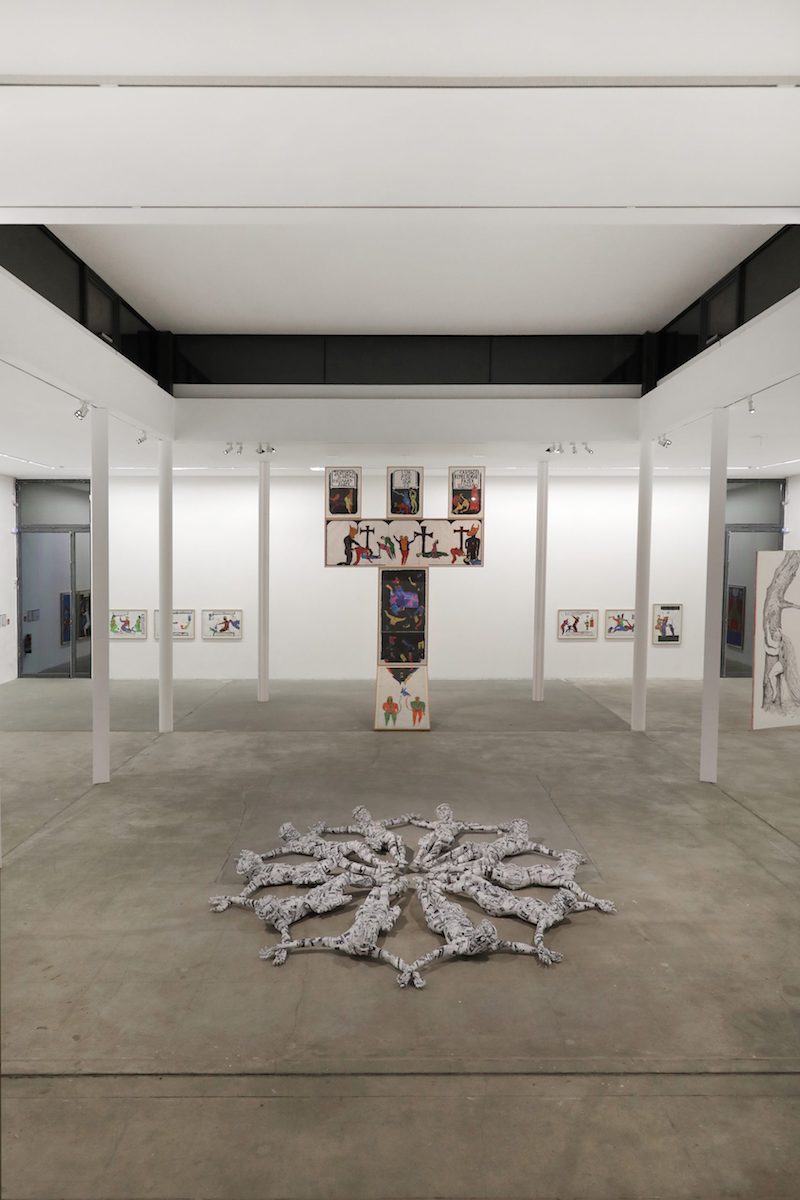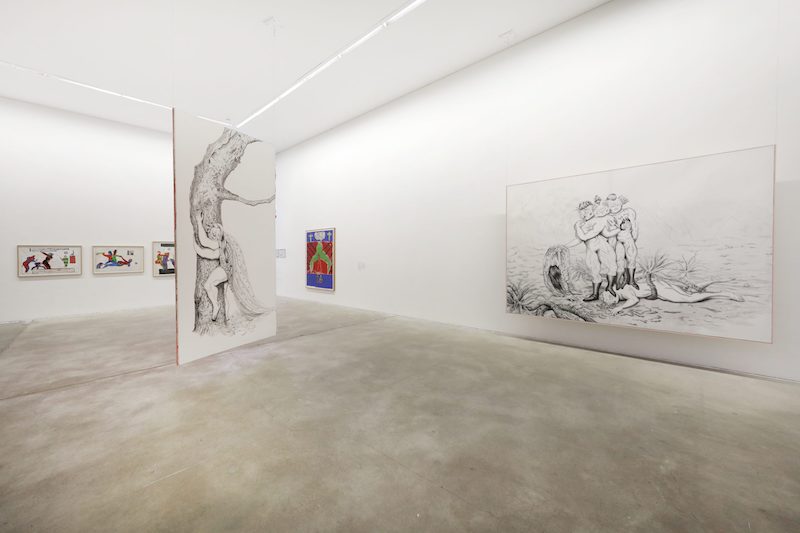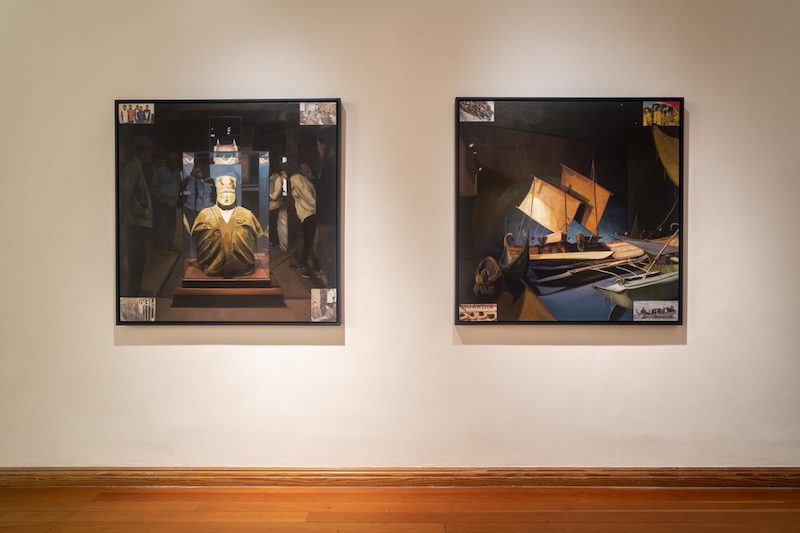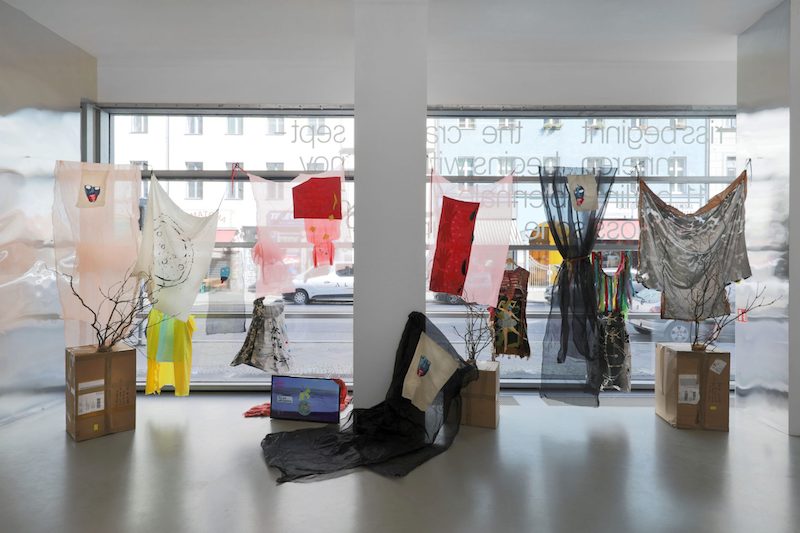Article by Tamaris Vier // Sept. 16, 2020
This year’s Berlin Biennale interrogates many forms of oppression enacted globally, coaxing to the surface seldom-heard stories of the marginalized, forgotten and violently silenced. An overwhelming selection of artworks, across four exhibition venues, prompts us to question the system in which we all live and take part.
The fourth and final part of the process-based exhibition, entitled ‘The Crack Begins Within’, is developed by a team of four, mostly South American curators: María Berríos, Renata Cervetto, Lisette Lagnado and Agustín Pérez Rubio. Each exhibition within the epilogue, as they call it, represents a different chapter of the show, taking place at KW Institute, Gropius Bau, daadgalerie and ExRotaprint.

Pedro Moraleida Bernardes, Young-jun Tak, Florencia Rodriguez Giles, Installation view, KW Institute for Contemporary Art, 5.9.–1.11.2020 // Photo: Silke Briel
KW, the long-standing center of the Biennale, hosts ‘The Antichurch’. The title is as disruptive as the works that await visitors on KW’s three floors, ranging from video works to sculpture and collage to paintings and drawings. Religious references run through all of them, highlighting the destructive power of religion and its entanglement with patriarchy. The bold materiality of the works is a defining characteristic of this show.
Figurative physical elements appear in an abstract, often surreal context, where different mediums convey a palpable estrangement. Pedro Moraleida Bernardes’ paintings strike the viewer, popping with saturated colours, forming violent biblical scenes. Fragmentation and confusion are reflected in limbs that are separated from their bodies, reptile creatures and grotesque sexual acts. The Christian symbol of the cross, standing still and threatening in the middle of the chaos, repeats throughout the exhibited works by the Brasilian artist.
The large-scale pencil drawings by Argentinian artist Florencia Rodriguez Giles, certainly among the most conspicuous works, seem to suggest an alternative to suppression: a solution, rooted in nature and femininity. The drawings depict strange creatures, each devoted to lust and desire, and also point to spiritual liberation. Forms and body parts melt into each other, escaping from while urging towards each other at the same time. Their bodies appear strong and vibrant and stand as a psychedelic counterpart to the tortured characters in Moraleida Bernardes’ works.

Florencia Rodriguez Giles, Installation view (detail), 11th Berlin Biennale, KW Institute for Contemporary Art, 5.9.–1.11.2020 // Photo: Silke Briel
At Gropius Bau, we are offered a multitude of artistic approaches to colonialism, aiming to expose the narratives of those in power, which, to this day, dominate history. The exhibition is titled ‘The Inverted Museum’, hinting at the instrumentalization of museums as mediums of Western-centric storytelling. Over hundreds of years, objects of non-Western cultures have been presented in a framework that covers up the process of destruction and exploitation that led to their acquisition. The exhibition strives to uncover the crimes of an unjust system and reappraise its history.
Throughout the first part of the exhibition, the erasure of indigenous cultures is reflected in the special lighting of the gallery space. Light is used to expose and highlight particular parts of the display, while the rest of the room fades into darkness and escapes our eye. As a metaphor for a fragmented and censored image, which is transferred by a capitalist system, the visitor’s gaze is led to discover what lies underneath the surface of false narratives.

Sandra Gamarra Heshiki, Installation view (detail), 11th Berlin Biennale, Gropius Bau, 5.9.–1.11.2020 // Photo: Mathias Völzke
In the first room of the exhibition, we are confronted with five big, dark paintings by Sandra Gamarra Heshiki. The depth of the still life scenes, which show non-Western objects exhibited in different European anthropological museums, creates an immersive atmosphere. The very recent works are part of her series ‘Cryptomnesia (or in some museums the sun never shines)’. In the corners of each painting, inserted photographs of violent scenes, portraying ongoing crimes, disturb the dark stillness and address colonialism as an issue of today, reminding us that there is not only a history to process but also an ongoing colonial present to face.
Another outstanding work is Andrés Pereira Paz’s installation, which takes us on an audiovisual trip to the Amazon. Following the journey of the guajojó bird, which was forced to escape its natural habitat due to destructive fires, we hear its call and heartbeat without seeing it. The installation is based on a true story of a solitary bird flying to Bolivia in order to find safety. Facing the issue of migration through a bird’s perspective, we dive into this dim room, illuminated by orange lamps, which give the impression of burning fire. It’s filled with golden sculptural stars, whose forms refer to old line drawings, showing the destruction of ecosystems and indigenous communities.

Andrés Pereira Paz: ‘EGO FVLCIO COLLVMNAS EIVS [I FORTIFY YOUR COLUMNS]’, 2020, Mixed media, Installation view, 11th Berlin Biennale, Gropius Bau, 5.9.–1.11.2020 // Photo: Mathias Völzke, courtesy of Andrés Pereira Paz; Crisis Galería, Lima; Galería Isla Flotante, Buenos Aires

Delaine Le Bas: ‘St Sara Kali George,’ 2020, Mixed media, Installation view, 11th Berlin Biennale, daadgalerie, 5.9.–1.11.2020 // Photo: Silke Briel, courtesy of Delaine Le Bas; Yamamoto Keiko Rochaix, London
While KW and Gropius Bau focus on large-scale critiques of the institutions of the church and the museum, daad gallery deals with body politics in an exhibition titled ‘Storefront for Dissident Bodies’. The exhibited works consider transgression, as a form of dressing up against oppression. The storefront window shows different pieces of textile, each supporting a queer and emancipatory perspective. Inside the exhibition, colourful and vivid installations, ranging from textile to video to collage works, are arranged in front of iridescent silver walls.
The strong spiritual focus, which forms the core of the Biennale’s curatorial concept, aims to revive the spirits of indigenous cultures seeking collective healing. It remains to be seen whether this particular approach—colored by terms like purge and sacrifice—can function as a countermovement. However, turning the oppressor’s tools against themselves in these exhibitions, the curators provoke a discussion that gains even more importance today, in the midst of a pandemic: how do we build new forms of collectivity and community through engagement and activism, in order to stand up against injustice?
Exhibition Info
11th Berlin Biennale of Contemporary Art
Group Show: ‘The Crack Begins Within’
Exhibition: Sept. 5–Nov. 1, 2020
11.berlinbiennale.de
Various Venues, click here for more info






















